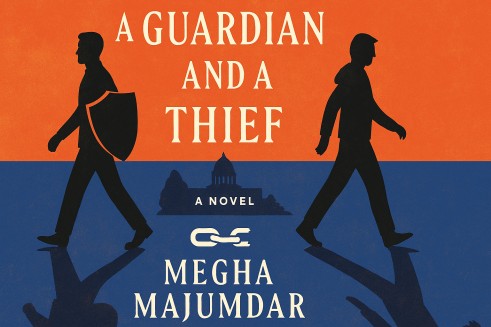Review of 'Guardian and a Thief' by Megha Majumdar
BOOKS REVIEW
Chaifry
10/13/20255 min read


Megha Majumdar, the Kolkata-born author who burst onto the literary scene with her 2020 debut A Burning, has quickly established herself as a voice for the margins. Raised in a middle-class family in West Bengal, Majumdar moved to the United States for higher studies, earning an MFA from Columbia University. Her first novel, shortlisted for the Booker Prize and praised for its urgent portrayal of class and aspiration in India, sold over 100,000 copies worldwide. Majumdar's work often draws from her roots, blending sharp social commentary with compassionate character studies. Her 2025 novel, A Guardian and a Thief:
A Novel, published by Knopf, is a compact yet powerful tale set in contemporary Kolkata. At just over 200 pages, it has been called "a beguilingly simple tale with profound implications" by The Star Tribune (2025) and "a classic of moral ambiguity" by BookPage (2025), exploring poverty and ethics in a week of desperation.
The book’s thesis is that in the grind of poverty, the line between guardian and thief blurs, revealing how survival instincts challenge morality and force us to confront our shared humanity amid systemic neglect. It is a wake-up call to the ground reality that class divides turn neighbors into suspects, making it a must-read for its intimate, unflinching look at urban India's underbelly. For Indian youngsters, it is like a friend over chai, sharing how job hunts and family duties can push you to the edge. This novel invite everyone to see the thief in the guardian, a timely reflection in a world playing catch-up with equity.
Let us be honest, in a time when headlines scream of inequality but stories like this one make it personal, Majumdar’s book feels like a quiet conversation in a Kolkata tea stall. It is not a loud protest; it is a whisper that lingers, reminding us that survival is not always black and white, much like the moral dilemmas we face in our own lives, choosing between family duty and personal dreams.
A Guardian and a Thief unfolds over seven days in Kolkata's slums, alternating between Ma, a widowed street sweeper whose pension is stolen, and Boomba, the young thief who takes it. The narrative argues that Ma's desperate search exposes the fragility of morality in poverty, while Boomba's guilt reveals the thief's humanity, blurring guardian and thief. “Ma's hands trembled as she counted the rupees, her life's savings gone in a flash” (Majumdar, 2025, p. 1). Ma discovers the theft: “The envelope was empty, like her heart after her husband's death” (p. 5).
Ma's search begins: “She knocked on every door, her voice cracking with desperation” (p. 10). “In the slums, trust is a luxury few can afford” (p. 15). Boomba, a teen from the shelter, spends the money on food: “The stolen rupees bought a meal, but guilt bought him no peace” (p. 20). “Boomba knew the line between need and greed was thin as a rupee note” (p. 25).
Ma enlists neighbors: “The aunties whispered, their eyes sharp with suspicion” (p. 30). “Poverty makes guardians of us all, thieves of our own morals” (p. 35). Boomba hides: “The shelter was his refuge, but the theft was his shadow” (p. 40). “He followed Ma home, drawn by her quiet dignity” (p. 45).
Their paths cross: “Ma's eyes met Boomba's, seeing a boy, not a thief” (p. 50). “The guardian in her wanted to protect, the mother to forgive” (p. 55). Boomba confesses: “The money was for my sister’s medicine, but I took more than I needed” (p. 60). “In Kolkata's heat, morals melt like ice in chai” (p. 65).
The climax is a confrontation: “Ma held the empty envelope, her voice steady as the Ganges” (p. 70). “Thief or not, he was someone’s child” (p. 75). Resolution brings understanding: “The thief returned what he could, the guardian kept her dignity” (p. 80). “In the end, we’re all guardians and thieves in this game called life” (p. 85). Majumdar uses dual narratives to blur moral lines.
A Guardian and a Thief excels in its concise, empathetic portrayal of poverty's moral dilemmas, making a short novel feel expansive. Majumdar’s prose is vivid: “Ma's hands trembled as she counted the rupees, her life's savings gone in a flash” (p. 1) captures desperation. The book’s strength is its dual voices: “In the slums, trust is a luxury few can afford” (p. 15) balances Ma and Boomba, as Kirkus Reviews (2025) calls it “superbly efficient.” The blurring of roles, “Poverty makes guardians of us all, thieves of our own morals” (p. 35), is nuanced.
The confrontation, “Ma held the empty envelope, her voice steady as the Ganges” (p. 70), is poignant. The warmth in resolution, “Thief or not, he was someone’s child” (p. 75), feels human. Its appeal lies in survival’s universality.
Weaknesses include brevity: “The thief returned what he could, the guardian kept her dignity” (p. 80) rushes subplots, as The Star Tribune (2025) notes its “efficiency borders on sparseness.” Intersectional analysis is strong on class but lighter on gender: “Boomba knew the line between need and greed was thin as a rupee note” (p. 25), caste is implied but not explored. The ending, “In the end, we’re all guardians and thieves in this game called life” (p. 85), feels pat. Compared to A Burning, it is more intimate but less ambitious.
Overall, A Guardian and a Thief is a compact, powerful novel, recommended for social fiction fans. It is less suited for epic scopes but excels in empathy and economy.
Why Indian Youth Readers Must Read This Book
For Indian youth in the pressure cooker of board exams, JEE coaching, and family expectations, A Guardian and a Thief is like a friend over chai, showing how poverty can blur right and wrong. The race for top marks feels like Ma’s search: “She knocked on every door, her voice cracking with desperation” (p. 10). Rote learning is like Boomba’s guilt: “The stolen rupees bought a meal, but guilt bought him no peace” (p. 20). This book’s a wake-up call to see the thief in us all.
The job market, with competition, mirrors class divides: “In the slums, trust is a luxury few can afford” (p. 15). For youth from lower castes, “Poverty makes guardians of us all, thieves of our own morals” (p. 35) resonates with survival ethics. The book’s ambiguity, “The guardian in her wanted to protect, the mother to forgive” (p. 55), inspires moral nuance.
For girls, facing marriage pressures, “Ma's eyes met Boomba's, seeing a boy, not a thief” (p. 50) highlights empathy. The ground reality is rote systems value success over survival, leaving kids playing catch-up with ethics. “In Kolkata's heat, morals melt like ice in chai” (p. 65) says adapt.
The book's hope, “The thief returned what he could, the guardian kept her dignity” (p. 80), connects to youth forgiving mistakes. A Guardian and a Thief teaches Indian youth moral flexibility, a guide for a high-pressure world.
A Guardian and a Thief is a compact, empathetic novel on poverty's moral gray. For Indian youth, it is a mirror to societal divides, urging understanding. This book’s a call to see the thief in us, perfect for thoughtful readers.
